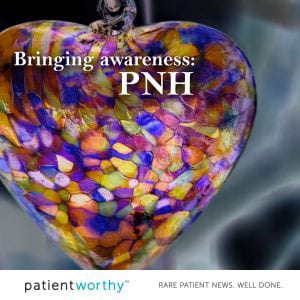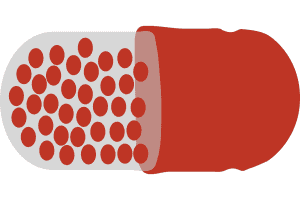Editor’s Note: We believe that patients are a key part of developing and leading the conversation in disease communities. Patient Worthy sometimes partners with reputable agencies that wish to speak with patients about opportunities related to their diagnosed conditions. These opportunities can include activities such as sharing stories with other patients or health professionals about their diagnosis journey or recording video testimonials. To learn more about how to get involved with an opportunity for individuals impacted by paroxysmal nocturnal hemoglobinuria, click the button below.
Welcome to the Rare Classroom, a new series from Patient Worthy. Rare Classroom is designed for the curious reader who wants to get informed on some of the rarest, most mysterious diseases and conditions. There are thousands of rare diseases out there, but only a very small number of them have viable treatments and regularly make the news. This series is an opportunity to learn the basics about some of the diseases that almost no one hears much about or that we otherwise haven’t been able to report on very often.
Eyes front and ears open. Class is now in session.

The disease that we will be learning about today is:
Paroxysmal Nocturnal Hemoglobinuria
Less commonly called Marchiafava-Micheli syndrome.
What is Paroxysmal Nocturnal Hemoglobinuria?
- PNH is an ultra-rare, life-threatening blood disorder in which uncontrolled activation of complement, a component of the normal immune system, results in chronic hemolysis (destruction of the patient’s red blood cells)
- PNH affects 1-1.5 persons per million of the population and is primarily a disease of younger adults. The median age of diagnosis is 35-40 years of age, with occasional cases diagnosed in childhood or adolescence.
- Historically, PNH was diagnosed by demonstration of the complement-sensitive red blood cells 20. Now the diagnosis is made by flow cytometry, using a combination of fluoresceinated antibodies to proteins normally present on the various blood cells.
- The most devastating consequence of hemolysis in PNH is thrombosis (blood clotting), which can damage organs and cause premature death. Thrombosis can occur in blood vessels throughout the body, and the first thrombotic event can be fatal.
- PNH develops without warning and can occur in people of all races, backgrounds, and ages.
- The average age of onset is in the early 30s. Historically, up to 35% of patients with PNH treated with available supportive care did not survive beyond five years from diagnosis due to serious clinical outcomes such as thromboembolism (blockage of a blood vessel by a blood clot) and chronic kidney disease (CKD).
- The condition has three main subtypes: classical PNH, which includes patients who have evidence of PNH in the absence of another bone marrow failure disorder; PNH in the context of other primary bone marrow disorders, such as aplastic anemia or myelodysplastic syndrome; and subclinical PNH, in which patients have small PNH clones but no clinical or laboratory evidence of hemolysis (red blood cell destruction) or thrombosis (blood clots).
- PNH affects only about 8,000 to 10,000 people in North America and Western Europe. It is an acquired disease and is not genetically inherited from a family member. Some patients with aplastic anemia, a disease that affects the bone marrow and causes low blood counts can develop PNH.
How Do You Get It?
- PNH occurs when mutations of a gene called PIG-A occur in a bone marrow stem cell.
- The affected stem cell passes the PIG-A mutation to all cells derived from the abnormal stem cell. Cells harboring PIG-A mutations are deficient in a class of proteins called GPI-anchored proteins. Certain GPI-anchored proteins protect red blood cells from destruction, some are involved in blood clotting, and others are involved in fighting infection.
- The risk for developing PNH after treatment for aplastic anemia with immunosuppressive therapy (anti-thymocyte globulin and cyclosporine) is approximately 20% to 30%.
- PNH can occur at any age; the average age at diagnosis is in the early 30s
What Are The Symptoms?
- Due to the wide spectrum of symptoms associated with PNH, it is not unusual for months or years to pass before the correct diagnosis is established. Overall, the most common symptoms of PNH include:
- Significant fatigue or weakness
- Bruising or bleeding easily
- Shortness of breath
- Recurring infections and/or flu-like symptoms
- Difficulty in controlling bleeding, even from very minor wounds
- The appearance of small red dots on the skin that indicate bleeding under the skin
- Severe headache
- Fever due to infection
- Blood clots (thrombosis)
- Blood clots (thrombosis) occur almost exclusively in veins, as opposed to arteries, and are the leading cause of death in PNH.
- The most common sites for blood clots are in the hepatic vein (a vein that drains the liver).
- Clots here are also referred to as Budd-Chiari syndrome and can impact the sagittal vein (a vein in the head). However, they can occur in any vein, especially those in the abdomen.
- Trouble swallowing
- Erectile dysfunction
- Anemia
- Almost all patients are anemic due to two causes: intravascular hemolysis and relative bone marrow hypofunction of the underlying marrow disorder.
- The anemia may vary depending upon the severity of intravascular hemolysis and relative bone marrow hypofunction.
- Other issues include abdominal pain crises and back pain. The classic symptom of bright red blood in the urine (hemoglobinuria) occurs in 50% or less of patients. Frequently patients notice their urine is the color of dark tea.
- Typically, hemoglobinuria will be most noticeable in the morning and clear as the day progresses.
- Attacks of hemoglobinuria may be brought on by infections, alcohol, exercise, stress, or certain medications.
- Many patients note a feeling of fatigue that may be disabling during periods of hemoglobinuria.
- Excessive fatigue does not appear to be related to the degree of anemia, as it improves when the hemoglobinuria abates.
- The disease is greatly varied in its severity and presentation.
- The reticulocyte count is usually elevated and haptoglobin markedly reduced.
- Chronic intravascular hemolysis is manifested by an elevation of the serum lactic acid dehydrogenase (LDH).
How Is It Treated?
- For many years, the treatment of PNH was symptomatic and consisted of iron replacement (much iron is lost through the kidneys), folic acid replenishment, and careful care of infections
- Transfusions of red blood cells were and are given as needed, care being taken to deplete the product of neutrophils by filtration or washing. Prednisone was sometimes used, but the dose needed was too high to permit daily use
- The drug eculizumab, which must be given intravenously every two weeks or so, completely or nearly completely stops the intravascular destruction of the red cells in PNH.
- This decreases the anemia and markedly reduces the transfusion requirement of almost all patients.
- Further, marked reduction in hemoglobinuria abrogates many of the symptoms of which patients complain – fatigue, dysphagia, abdominal pain, erectile dysfunction, and dyspnea.
- It appears to ameliorate the renal dysfunction but may not reverse all the damage to the kidneys.
- Eculizumab appears to reduce the incidence of thrombosis as well, presumably by reducing the activation of platelets by complement.
- Concurrent prophylactic anticoagulation appears to be unnecessary although continued anticoagulation is currently recommended for patients who have had an episode of thrombosis.
- Eculizumab appears to be well tolerated and continues to be effective after as long as ten years of use.
- The only apparent side effect is a slightly increased incidence of meningococcal sepsis which may be fatal if not promptly treated.
- All patients and their health care providers are warned to start appropriate antibiotics when the patient becomes febrile.
- Other approved medicines include Elizaria (eculizumab biosimilar) and Ultomiris (ravulizumab-cwvz)
- The latest approved treatment is pegcetacoplan, which received FDA approval in May 2021.
- All patients with PNH also have an underlying marrow dysfunction, usually characteristic of aplastic anemia and occasionally that of myelodysplastic syndrome.
- When the aplasia is severe, stem cell transplantation may be needed. Since the advent of eculizumab, much of the morbidity and mortality in PNH patients is due to the underlying aplasia and not to PNH itself
- Bone marrow transplantation (BMT) is the only curative therapy for PNH.
- It is offered primarily only to patients who don’t have a good response to eculizumab.
- This is because of the potential risks of BMT, and because eculizumab in most cases controls the disease.
- Chronic hemolysis is the main cause of serious health problems in people with PNH and can lead to blood clots and end-organ damage.
- In healthy individuals, normal red blood cells (RBCs) are protected from complement attack by a shield of terminal complement inhibitors.
- These protective proteins inhibit uncontrolled complement activation and chronic hemolysis. In patients with PNH, the lack of these protective proteins renders RBCs vulnerable to lysis by complement.
- Without this protective complement inhibitor shield, PNH RBCs are destroyed (hemolysis), which can result in thrombosis, end-organ damage, and impaired health-quality of life.
- PNH is closely related to aplastic anemia. In fact, up to 30% of newly diagnosed cases of PNH evolve from aplastic anemia.
- Similarly, the risk of developing PNH after treatment for aplastic anemia with immunosuppressive therapy (anti-thymocyte globulin and cyclosporine) is approximately 20-30%.
- PNH is a chronic disease. Spontaneous remissions do occur, usually after a number of years, but these are uncommon. The mean life span in several studied Western populations observed before treatment with eculizumab was available is 10-15 years from diagnosis.
- Although it is too early to be certain, there are indications that this treatment greatly improves survival
Where Can I Learn More???
- Check out our cornerstone on this disease here.
- Learn more about this illness from the Aplastic Anemia and MDS International Foundation.
Interested in an opportunity to share your story related to paroxysmal nocturnal hemoglobinuria? Click here to learn more.







